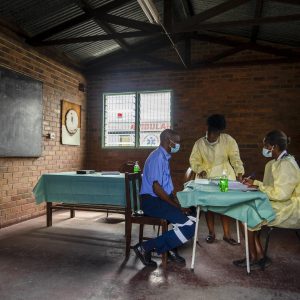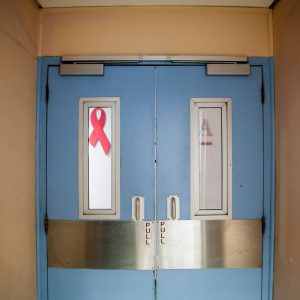Could HIV treatment be reduced to two medicines?
A big breakthrough in HIV treatment in the 1990s came when three different antiretrovirals were used together. Now, trials are showing that two might be as good as three.
Author:
1 December 2021

The medicines available for the treatment of HIV infection in the public sector in South Africa have changed significantly over the years. But one thing that hasn’t changed is that the standard treatment is made up of three different antiretrovirals (ARVs) – even if they come co-formulated in one pill.
The discovery of triple therapy for the treatment of HIV in the 1990s turned HIV from a death sentence into a manageable disease. The triple was critical, as people who only took one or two ARVs soon developed drug resistance and fell ill again. The idea that you need three ARVs accordingly became one of the cornerstones of HIV treatment in the quarter-century since.
Related article:
But, as discussed at the recent 2021 Southern African HIV Clinicians Society (SAHCS) conference, the era of exclusive triple therapy may be coming to an end as evidence mounts in support of the safety and efficacy of new dual therapy (two-drug) regimens.
Why dual if triple is so good?
Speaking at the SAHCS conference, scientific director of the Huesped Foundation in Argentina Pedro Cahn acknowledged that the current three-drug regimens are very effective and said that the aim of introducing dual therapy is to make treatment more comfortable for people who have HIV.
A dual therapy regimen firstly reduces the drug burden (from three to two), which Cahn said can improve patient adherence and quality of life. He said this can help meet the needs of the ageing HIV population by reducing antiretroviral exposure, making treatment safer without sacrificing virologic control, as well as reducing drug-drug interactions and costs.
Related article:
Michelle Moorhouse, senior global medical director at pharmaceutical company ViiV Healthcare, elaborated on the potential benefits of two-drug regimens. “For example, fewer ingredients mean a smaller pill size, which means smaller and lighter packaging,” she said. This can reduce transport and distribution costs, and more stock can be stored in facilities.
“Fewer ingredients should also reduce long-term exposure to additional antiretrovirals, which may have long-term toxicity … and of course fewer ingredients should also directly reduce costs,” she said.
Dual therapy could be particularly beneficial for older people with HIV. “Management of the older person living with HIV is complex as they often have multiple comorbidities and are at risk of polypharmacy. Two-drug regimens offer exposure to fewer drugs and reduce the risk of unmanageable drug-drug interactions,” said Moorhouse.
Evidence for dual therapy
Historically, dual therapy has not been as effective as the current three-drug regimens, according to Cahn, but new drug combinations have shown promise in the past few years.
During his presentation, Cahn unpacked results from the landmark Gemini-1 and Gemini-2 studies. These were two identical double-blind, randomised, non-inferiority, phase-three trials that compared a once daily two-drug regimen of dolutegravir and lamivudine to a once daily three-drug regimen of dolutegravir, tenofovir disoproxil fumarate and emtricitabine. The study enrolled patients who had not taken antiretroviral treatment before.
According to Cahn, dolutegravir + lamivudine has demonstrated long-term durability and efficiency in patients with a high viral load and CD4+ T-cell count of <200 cell/mm³. No treatment-emergent resistance was observed among participants who met virologic withdrawal in the Gemini-1 and Gemini-2 studies at week 48 or week 96, according to Cahn, and the safety and biomarkers generally favoured dolutegravir + lamivudine.
Related article:
The studies also showed that there was a significantly lower risk of drug-related adverse events with the two-drug combination, 20% compared with 27% for the three-drug combination. But a higher mean weight gain of 3.7kg was observed with dual therapy, compared with 2.4kg with triple therapy.
While Cahn said that optimal two-drug regimens are potent, convenient, well-tolerated and have a high barrier to resistance, he stressed that more research for these regimens needs to be done in pregnant women, children and people with HIV and tuberculosis (TB) co-infection.
Promising two-drug regimens
A systematic review, published in 2020 in the Infectious Diseases and Therapy journal, looked at 33 studies conducted on dual therapy, either as an initial treatment option or as a switch option.
The review concluded that lamivudine was the most commonly used nucleoside reverse transcriptase inhibitor (NRTI) in two-drug regimens that “met non-inferiority” in both treatment-naïve and treatment-experienced populations.
For now, it seems lamivudine is best paired with the integrase inhibitor dolutegravir, as was done in the Gemini studies.
Related article:
According to the review, dolutegravir + lamivudine is the most promising NRTI-inclusive two-drug regimen for patients initiating antiretroviral therapy, so much so that recent guideline updates for the European Aids Clinical Society, as well as the Department of Health and Human Services in the United States, recommend that the combination is considered as a treatment option in treatment-naïve patients, except for individuals with viral loads above 500 000 copies/ml, or active hepatitis B virus co-infection.
According to the review, lamivudine in combination with a boosted protease inhibitor also showed efficacy in treatment-naïve patients. For example, the Andes and Gardel studies found that lamivudine + darunavir/ritonavir and lamivudine + lopinavir/ritonavir were non-inferior to three-drug regimens.
Long-acting, injectable dual therapy
While dolutegravir + lamivudine is the frontrunner for dual therapy taken as a pill, other combinations are leading the way when it comes to dual therapy taken as a long-acting injection.
In her conference presentation, Moorhouse focused on the long-acting injectable combination of cabotegravir and rilpivirine. According to Moorhouse, the Atlas and Flare studies demonstrated that a monthly injection of this combination was non-inferior to daily oral antiretroviral therapy. Preliminary data from the Atlas 2M study went further to show non-inferiority of two-monthly compared to monthly dosing.
Related article:
Injectable dual therapy consisting of cabotegravir and rilpivirine was approved by the US Food and Drug Administration in January 2021. It is not listed as a registered product on the website of the South African Health Products Regulatory Authority.
Challenges in South Africa
While developments in dual therapy are exciting, there are also potential barriers to rolling out two-drug regimens in South Africa, according to division head of Ezintsha at the University of the Witwatersrand, Francois Venter.
One concern for Venter is that women, particularly pregnant women, are underrepresented in a lot of studies on new HIV drugs, including studies on two-drug regimens. He says more data for this population is required.
Another barrier that can hinder the adoption of dual therapy, particularly the dolutegravir + lamivudine regimen, is the high prevalence of hepatitis B in the country. “It’s important to understand that in many ways, hepatitis B is the biggest gatekeeper to two drug therapies at the moment, including dolutegravir + lamivudine,” Venter said.
As Moorhouse pointed out, dolutegravir + lamivudine may treat HIV, but is insufficient to treat hepatitis B. It thus follows that people should be screened for hepatitis B before being started on dual therapy – in the absence of such screening, triple therapy would be a safer option.
Related article:
According to the national guidelines for the management of viral hepatitis, published in 2019, hepatitis B “is endemic in South Africa, resulting in a significant burden of clinical disease as a result of the progression to cirrhosis and the development of the complications of liver failure or hepatocellular carcinoma”. Hepatitis B prevalence estimates for South Africa vary widely, with the best evidence suggesting that it is around 6.7% overall, with higher rates in people living with HIV. Tenofovir, which forms part of standard triple therapy HIV treatment in South Africa, is also used to treat hepatitis B.
“If we can’t screen for hepatitis B, we can’t use it (dolutegravir + lamivudine) … I don’t think HIV programmes should be held hostage for the rest of time to the hepatitis B programme,” Venter said. “We do acknowledge that’s important, but it’s not important enough to inform first-line therapies to the detriment of people having access to new and innovative therapies.”
TB drug interactions
Another problem is that rifampicin, a critically important medicine for the treatment of drug-sensitive TB, interacts with many of the drugs found in the current dual therapy HIV regimens.
“TB is a constant problem, and rifampicin is such a potent driver of drug interactions and it has drug interactions with almost every one of the dual therapy agents we’re looking at at the moment other than lamivudine,” Venter said.
Yet, Venter explained that there are excellent first and second-line treatment options for people living with HIV who also have a TB infection, and those drugs can be used to treat those patients instead of dual therapy regimens. “We have potent drug programmes for these patients and it’s not a deal-breaker anymore,” he said.
Programmatic issues
For Venter, the programmatic issues in South Africa are the biggest headache.
He explained that while patients are closely monitored and there are follow-ups during clinical trials, patients in the real-world setting in clinics are not followed up as closely. This poses a big problem when rolling out dual therapies, particularly long-acting therapy. If patients miss their appointments for long-acting treatments, this can be disastrous from a resistance perspective.
He said that healthcare workers and patients would need to undergo training for using dual therapy, particularly the long-acting injectables. He added that the cost of dual therapies and potential logistical challenges like some long-acting injectable dual therapies requiring cold chain storage would also need to be considered.
Related article:
Another factor that the government and donors will need to consider, according to Venter, is whether dual therapy will be licensed and if generics will be produced, as this will also affect cost.
“We must not underestimate the programmatic issues,” Venter said, “and we must start thinking hard now, starting to put our heads together, start thinking [about getting these] things out to everyone that needs them. Because if it does come, we need to make sure that we’re in a much stronger position to milk the benefits of this new, exciting innovation as quickly as humanly possible in first and second-line therapy as we go forward.”







